
Lard and tallow are popular soapmaking ingredients. Tallow is the rendered fat of animals, and usually refers to fat from cows and sheep. Lard refers to pig fat. Lard and tallow give soap firmness and contribute to a stable lather. Because of these properties, both tallow and lard are common substitutes for palm oil.
Lard and tallow can be purchased from the store, or you can render your own at home. Rendering your own tallow is a great way to reduce, reuse and recycle. In the spirit of Earth Day this Friday, I saved bacon grease from an epic Bramble Berry staff lunch cooking extravaganza to use in this palm-free recipe. First, the bacon grease needed to be cleaned up to reduce the smell and remove any bacon bits. Click here to see the process. I also used leftover yogurt containers as the molds in this recipe. I love the cute little shape! Click here for more ideas on using recyclables for soap molds.

Once the bacon grease was cleaned up, I used it at 30% of my total recipe. I generally recommend using lard and tallow at 50% or less in your cold process recipes. If you’re looking for more tallow recipes, check out this guest post by Eric Vought for tallow laundry soap. I added shredded loofah to the bottom layer of these bars for exfoliation. The top layer contains carrot puree, which gives the soap a soft yellow color and additional creaminess. For more information on using purees in cold process soap, click here.

What You’ll Need:
8 Clean Yogurt Contains
4.8 oz. Lard, I used leftover bacon grease (30%)
8 oz. Olive Oil (50%)
3.2 oz. Coconut Oil (20%)
2.2 oz. Sodium Hydroxide Lye
5 oz. Distilled Water
.2 oz. Bergamot Essential Oil
.3 oz. Black Pepper Essential Oil
1 heaping Tbs. Carrot Puree
2 Tbs. Shredded Loofah

Click here to add everything you need for this project to your Bramble Berry shopping cart!
If you’ve never made Cold Process soap before, stop here! I highly recommend checking out our FREE four part SoapQueen.tv series on Cold Process Soapmaking, especially the episode on lye safety. And if you’d rather do some reading, Bramble Berry carries a wide range of books on the topic, including my newest book, Pure Soapmaking. You can also checkout the digital downloads for that instant gratification factor.
SAFETY FIRST: Suit up for safe handling practices! That means goggles, gloves and long sleeves. Make sure kids, pets, and other distractions and tripping hazards are out of the house or don’t have access to your soaping space. Always soap in a well-ventilated area.
MOLD PREP: For this project, I used clean, empty plastic yogurt containers. They make great soap molds because the soap does not stick to them, and they are slightly flexible which helps when unmolding. My eight containers were 6 ounces each, but you could use a different size if that’s what you have on hand. You could also use a completely different container, click here for more mold ideas. Just make sure the containers are completely clean before use. I like the idea of reusing, especially in honor of Earth Day. Do note the glass container in the photo below is to showcase the carrot puree; don’t make soap in glass containers. You’ll never get it out. =)
 PUREE PREP: For this recipe, I used store bought carrot puree (aka baby food). If you’d like you can certainly make your own carrot puree at home. If purchasing puree from the store, just make sure the only ingredients are carrots and water. If the puree contains other ingredients, it may have unpredictable effects on the soap.
PUREE PREP: For this recipe, I used store bought carrot puree (aka baby food). If you’d like you can certainly make your own carrot puree at home. If purchasing puree from the store, just make sure the only ingredients are carrots and water. If the puree contains other ingredients, it may have unpredictable effects on the soap.
FRAGRANCE PREP: Measure .2 ounces of the bergamot essential oil and .3 ounces of the black pepper essential oil in a glass container. Set aside.
ONE: Slowly and carefully add the lye to the water and gently stir until the lye has fully dissolved and the liquid is clear. Set aside to cool.
TWO: Melt and combine the coconut oil, olive oil and lard. Once the lye water and the oils have cooled to 130 degrees or below (and are ideally within 10 degrees of each other), add the lye water to the oils and stick blend until thin trace. If you’d like a harder bar of soap that releases faster from the mold, you can add sodium lactate to the cooled lye water. Use 1 teaspoon of sodium lactate per pound of oils in the recipe. For this recipe, you’d add about 1 teaspoon sodium lactate. Because this recipe contains a high amount of olive oil, don’t be surprised if the soap takes a little bit longer to trace.
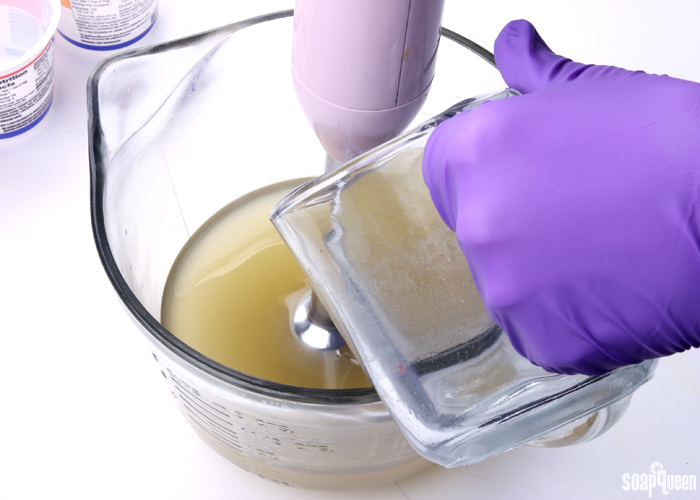
 THREE: Once you’ve reached a thin trace, add the essential oil blend and stick blend until fully emulsified.
THREE: Once you’ve reached a thin trace, add the essential oil blend and stick blend until fully emulsified.
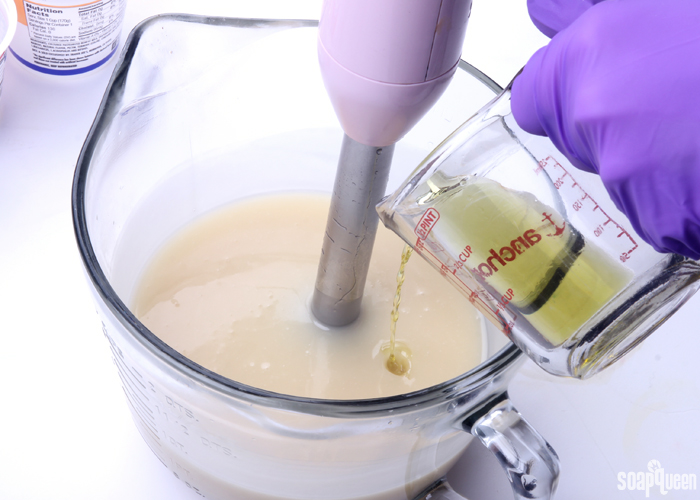 FOUR: Split off about half of the batter. It’s okay to eyeball it!
FOUR: Split off about half of the batter. It’s okay to eyeball it!
 FIVE: To this container, add 2 tablespoons of shredded loofah and use a whisk or spoon to thoroughly mix in.
FIVE: To this container, add 2 tablespoons of shredded loofah and use a whisk or spoon to thoroughly mix in.
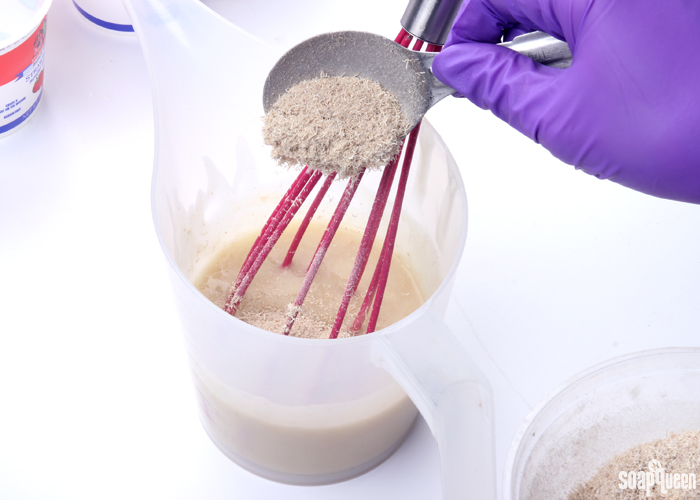 SIX: Pour the loofah soap evenly into each yogurt container.
SIX: Pour the loofah soap evenly into each yogurt container.
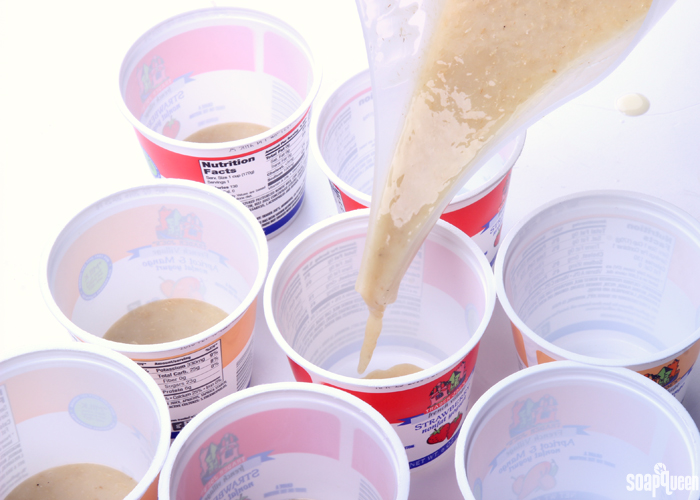 SEVEN: To the remaining soap, add 1 heaping tablespoon of the carrot puree and use a whisk or the stick blender to thoroughly mix in.
SEVEN: To the remaining soap, add 1 heaping tablespoon of the carrot puree and use a whisk or the stick blender to thoroughly mix in.
 EIGHT: Carefully pour the carrot puree soap into the yogurt containers evenly. Try your best to not break the bottom layer. If you need to, use a spoon to gently add the soap on top.
EIGHT: Carefully pour the carrot puree soap into the yogurt containers evenly. Try your best to not break the bottom layer. If you need to, use a spoon to gently add the soap on top.
 NINE: Tap each yogurt container on the counter firmly to help eliminate bubbles. Spritz the top of the soap with rubbing alcohol to help prevent soda ash. Allow the soaps to stay in the mold for about one week. Because of the high amount of olive oil in this recipe, it may require a little extra time in the mold. Once the soaps have hardened, remove from the yogurt containers and allow the soap to cure for 4-6 weeks. Enjoy!
NINE: Tap each yogurt container on the counter firmly to help eliminate bubbles. Spritz the top of the soap with rubbing alcohol to help prevent soda ash. Allow the soaps to stay in the mold for about one week. Because of the high amount of olive oil in this recipe, it may require a little extra time in the mold. Once the soaps have hardened, remove from the yogurt containers and allow the soap to cure for 4-6 weeks. Enjoy!


Click to View the Recipe
- 8 Clean Yogurt Contains
- 4.8 oz. Lard, I used leftover bacon grease
- 8 oz. Olive Oil
- 3.2 oz. Coconut Oil
- 2.2 oz. Sodium Hydroxide Lye
- 5 oz. Distilled Water
- .2 oz. Bergamot Essential Oil
- .3 oz. Black Pepper Essential Oil
- 1 heaping Tbs. Carrot Puree
- 2 Tbs. Shredded Loofah
- Slowly and carefully add the lye to the water and gently stir until the lye has fully dissolved and the liquid is clear. Set aside to cool.
- Melt and combine the coconut oil, olive oil and lard. Once the lye water and the oils have cooled to 130 degrees or below (and are ideally within 10 degrees of each other), add the lye water to the oils and stick blend until thin trace. If you’d like a harder bar of soap that releases faster from the mold, you can add sodium lactate to the cooled lye water. Use 1 teaspoon of sodium lactate per pound of oils in the recipe. For this recipe, you’d add about 1 teaspoon sodium lactate.
- Once you’ve reached a thin trace, add the essential oil blend and stick blend until fully emulsified.
- Split off about half of the batter. It’s okay to eyeball it!
- To this container, add 2 tablespoons of shredded loofah and use a whisk or spoon to thoroughly mix in.
- Pour the loofah soap batter evenly into each yogurt container.
- To the remaining soap batter, add 1 heaping tablespoon of the carrot puree and use a whisk or the stick blender to thoroughly mix in.
- Carefully pour the carrot puree soap into the yogurt containers evenly.
- Tap each yogurt container on the counter firmly to help eliminate bubbles. Spritz the top of the soap with rubbing alcohol to help prevent soda ash. Allow the soaps to stay in the mold for about one week. Once the soaps have hardened, remove from the yogurt containers and allow the soap to cure for 4-6 weeks. Enjoy!


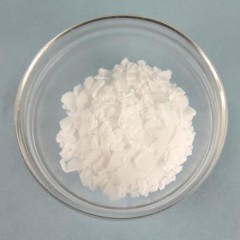
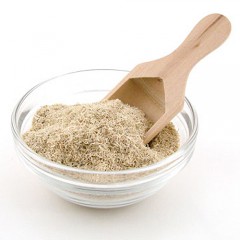




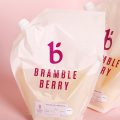


Have you made this soap with bacon fat and unscented? I’m just curious if it ends up having a yucky smell.
If the bars don’t have added fragrance, there may be a subtle scent. You’ll find that with other oils as well – even olive oil bars can have a natural scent. I would recommend making a small test batch to see what you think. The scent is subtle and you may not mind it. If you’re not a fan, essential oils and fragrance oils can help.
Can I use goat milk instead of Water?
You can, goat milk adds a creamy feeling to the bars. We recommend freezing the milk beforehand to prevent scorching. Learn more about working with it here: http://www.soapqueen.com/bath-and-body-tutorials/tips-and-tricks/how-to-add-lye-to-milk-for-cold-process-soap/
I am looking for ways to include exfoliating ingredients into my soaps. How does shedded loofa compare to ground oats, or ground coffee? You are recommending to use 4 tablespoons of shredded loofa per pound of oils, right? Thanks for the info.
Shredded loofah is a medium exfoliant, so it provides a good amount of scrub. Ground oats are a fine exfoliant, and coffee grounds are a large exfoliant. The larger the exfoliant, the more intense the scrub. You can use any of the ones you mentioned based on your personal preference. We recommend starting with 1 teaspoon per pound of soap and adding more from there if you like.
Learn more about exfoliants here: https://www.soapqueen.com/bath-and-body-tutorials/tips-and-tricks/all-about-exfoliants/
-Kelsey with Bramble Berry
The containers of lard available in my local grocery stores all contain citric acid to preserve it. Can I use that for soap anyway? I prefer rendering from bacon as you taught in your tutorial, but I don’t always have enough.
Usually the citric acid is such a small amount it should be fine to use! Citric acid can react with the lye and bit and lower the pH slightly. That’s not a bad thing, it makes the bar a bit more gentle. You may want to make a small test batch with the lard just to be sure. 🙂
-Kelsey with Bramble Berry
is there any soap making recipe that recyles the cooking oils?
You can use recycled lard and tallow. I’ll link posts below that talk more about that.
How to Prepare Bacon Grease for Soapmaking: https://www.soapqueen.com/bath-and-body-tutorials/tips-and-tricks/render-lard-home/
Rendering Tallow for Soapmaking: https://www.soapqueen.com/bath-and-body-tutorials/tips-and-tricks/guest-post-rendering-tallow-soaping/
-Kelsey with Bramble Berry
Hi, do you think I could substitute the carrot puree for carrot fibers (the dry stuff that is leftover after I juice carrots). If it’s to dry could I cook it down with a bit of water. I would just need to know the carrot ratio to water. Thanks for all wonderful tips. Very helpful!
Janine
We haven’t used carrot fibers so I’m not entirely sure! I think it would help to add water to the mix to help the color disperse evenly. I would recommend a small test batch with about 1 teaspoon of carrot mixture per pound of soap. If you need to add more, you can go from there. That way you can see if the carrot fibers color the soap before making a full batch. 🙂
-Kelsey with Bramble Berry
Okay thanks. Would you recommend equal parts of water to carrot to create the puree?
I think that would be a good place to start! If you notice it’s too dry or too watery, you can adjust from there. 🙂
-Kelsey with Bramble Berry
Excuse the newbie in me, as this is only my 2nd soap batch… but the essential oil amounts seem high. I buy oils that are 1/3fl.oz. So if I am correct, I will need more than 1 bottle of oils for this recipe?
Oh good catch Sara, the amount for bergamot was incorrect! We updated it to .2 oz. bergamot and .3 oz. black pepper essential oil. Sorry about any confusion. 🙂
Learn more about blending essential oils safely here: https://www.soapqueen.com/bath-and-body-tutorials/tips-and-tricks/how-to-blend-essential-oils-safely/
-Kelsey with Bramble Berry
I won’t to make these when I visit my two sisters. Instead of 4.8 oz lard can I use 4.8 oz of palm? Also, can I use baby carrots food?
Also, I don’t think I will get yogurt containers, can I use the round mold from the green tea exfoliating kit?
P.S. Shame on me for letting won’t vs want leave my phone!
You can use palm oil instead! It will make the bars a bit firmer. Just make sure to run your recipe through the Lye Calculator after any substitutions: https://www.brambleberry.com/Pages/Lye-Calculator.aspx
You can use baby food as long as it’s just carrots and water! Watch out for additives, they can do weird things in soap. The baby food with just carrots and water works best. 🙂
-Kelsey with Bramble Berry
You can use the 12 Bar Round Mold, that will look really nice! 🙂
12 Bar Round Silicone Mold: https://www.brambleberry.com/12-Bar-Round-Silicone-Mold-P5214.aspx
-Kelsey with Bramble Berry
What can I use in place of the carrot purée? I made this recipe and my top color is not anywhere near your pretty color.
If you want to bump up that color, you can use a brighter hue like Yellow Oxide or Fizzy Lemonade! We recommend mixing 1 teaspoon of the powder colorant with 1 tablespoon of a lightweight liquid oil, like sweet almond. Then, add 1 dispersed teaspoon at a time until you get a color you like. 🙂
Yellow Oxide: https://www.brambleberry.com/Yellow-Oxide-Pigment-P4046.aspx
Fizzy Lemonade: https://www.brambleberry.com/Fizzy-Lemonade-Colorant-P4965.aspx
Learn more about coloring your soap here: http://www.soapqueen.com/bath-and-body-tutorials/tips-and-tricks/talk-it-out-tuesday-colorants/
-Kelsey with Bramble Berry
Thanks, Kelsey!
You’re welcome Jo! 🙂
Hi,
I made this recipe and really like it.
I used sodium lactate and unmolded some after one week but the soap stuck to the bottom of the containers. I waited another week to unmolded the rest but they stuck, too.
Any thoughts?
So glad you like this recipe Tamara! It will be on the softer side and can take a bit longer to harden up, which is why it may be sticking to the bottom. You can pop them in the freezer for a couple hours, then let them sit at room temperature for about 30 minutes. The soap will form a bit of condensation and can slide out of the mold more easily! You can also cut the containers and carefully peel them off the bars. That way the airlock breaks and they can pop out more easily. 🙂
-Kelsey with Bramble Berry
Thank you for your help!
You’re welcome! 🙂
I finally got around to trying this (a variation inspired by this), and the main point is I used lard I rendered myself and I have a true appreciation for how our ancestors made soap before store purchased fats, lye calculators and STICK BLENDERS. I simply replaced some of the coconut oil I normally use with lard and added some castor oil in place of some of the coconut oil. I rendered the lard 3 times and it still smelled a little like bacon, but that did not stick in the soap. It’s a beautiful bar and no doubt will be an excellent soap, too. Thanks for the article.
That is so true! We are definitely spoiled by stick blenders. They get the job done so fast. I’m glad your bars turned out well Eric. Enjoy. 🙂
-Kelsey with Bramble Berry
Made these today but subbed palm oil for lard portion. Smells delish. Can’t wait to use.
That’s awesome! I think you’ll really like the recipe Sadia. It’s moisturizing and helps exfoliate the skin nicely. 🙂
-Kelsey with Bramble Berry
Thanks for answering my unanswered question. I use lard so now I know I can use Palm oil
Debra
I do not use lard sorry
Palm oil is a great substitute for lard! They both add firmness to the bars. 🙂
This post on substituting oils in cold process soap has more tips: https://www.soapqueen.com/bath-and-body-tutorials/tips-and-tricks/how-to-substitute-oil-in-cold-process-recipes/
-Kelsey with Bramble Berry
Can I use Crisco as a substitute for lard?
Hi Angelika!
Crisco will add a different feeling to the soap than lard. It does tend to be softer, so overall the bars will be softer. Also, the ingredients in the vegetable shortening to change based on the cost of the oils. For instance, one batch of shortening may be harder because it has more palm oil, while one may be softer because it has more soybean oil.
I would recommend using palm oil as a substitute for lard. Both lard and palm oil add firming properties to your bars. 🙂
Palm oil: https://www.brambleberry.com/Palm-Oil-P3210.aspx
Read more about substituting oils in recipes here: https://www.soapqueen.com/bath-and-body-tutorials/tips-and-tricks/how-to-substitute-oil-in-cold-process-recipes/
-Kelsey with Bramble Berry
Hi,
Can one use chicken fat instead of lard or tallow?
Thank you?
Hi Emel!
You can use chicken fat! We have a section for that on our Lye Calculator: https://www.brambleberry.com/Pages/Lye-Calculator.aspx
Like other fats, it will need to be rendered to clean it. Unlike lard or tallow, it will be a bit softer. Because of that it will make the bars softer overall. If you like firmer bars, I would recommend adding hard oils like coconut and palm to the mix! Learn more about common oils and how to add them here: http://www.soapqueen.com/bath-and-body-tutorials/tips-and-tricks/free-beginners-guide-to-soapmaking-common-soapmaking-oils/
We haven’t done a lot of experimenting with chicken fat, so I would recommend a small test batch. That way you can test the bars and adjust the oil ratios to your liking. 🙂
-Kelsey with Bramble Berry
Thank you.
You’re welcome!
I just made a recipe with
25% Lard
20% rice bran oil
20% coconut oil
20% sunflower (high-oleic) oil
10% cocoa butter
5% castor oil
Does that sound like a good recipe to you? Thanks. 🙂
That looks like a great recipe! It will have nice bubbles and a bit of luxury from the cocoa butter. 🙂
-Kelsey with Bramble Berry
Thank you! I’m so glad to see soaping validity finally extended to lard and tallow, which are the most sustainable, locally-sourced fats for North American soapers. I bought a pound of palm oil once and its qualities weren’t superior to animal fats and didn’t justify the cost and controversies, in my opinion. My all-time favorite recipe uses lard at 62%. (Save some tallow for french fries!!) 🙂
You’re welcome Amy, glad you like the post! I love the way it feels in soap. 🙂
-Kelsey with Bramble Berry
I love lard soap y’all, but it’s just immoral to use bacon grease in soap when potatoes are in the house 🙂
Ha, that’s a good use for bacon grease as well! Yum. 🙂
-Kelsey with Bramble Berry
Hi,
I don’t use lard or tallow. What would you recommend as a good substitute??
Hi Dawnua!
Palm oil is a good substitute for lard and tallow. It adds nice firming properties to the soap, and can be added up to 33%. 🙂
Read more about common soapmaking oils, like palm, here: http://www.soapqueen.com/bath-and-body-tutorials/tips-and-tricks/free-beginners-guide-to-soapmaking-common-soapmaking-oils/
This post on substituting oils in cold process soap has some great tips as well: http://www.soapqueen.com/bath-and-body-tutorials/tips-and-tricks/how-to-substitute-oil-in-cold-process-recipes/
-Kelsey with Bramble Berry
Why the recommendation to use lard at 50% or less? Is it just personal preference or is there something more to it?
Other people may have other reasons, but I would not use a high amount of lard or tallow because the bar will be very hard. My first batch of soap was 100% lard and it was a sizeable batch. Although it worked well, it takes A LOT of friction to get a lather and the bar lasts seemingly forever. After one year, I still had some that was starting to smell funky so I used it in the laundry. To dissolve it, I had to shred it with a cheese grater AND THEN boil it in water. I hope this helps!
Hi there!
James is correct (thank you!) – higher than 50%, the bars can be quite firm. We like to keep the percentage of lard lower so the bar is a softer. It’s definitely personal preference though! If you prefer a firm bar, you can definitely add more lard. 🙂
-Kelsey with Bramble Berry
I love these! I use these little yogurt cups all the time for soap mixing. And they are perfect hand size!
So glad you love them Michael! We are big fans of recycled container molds. 🙂
-Kelsey with Bramble Berry